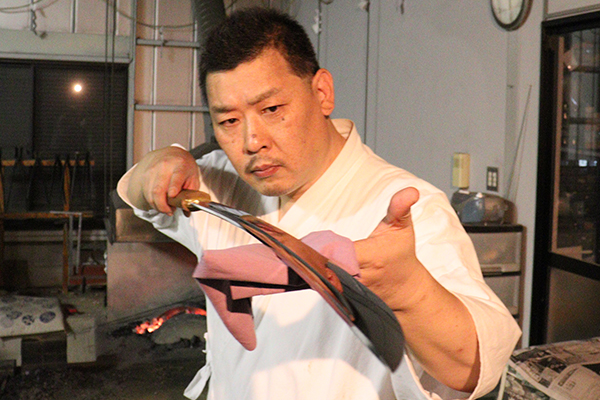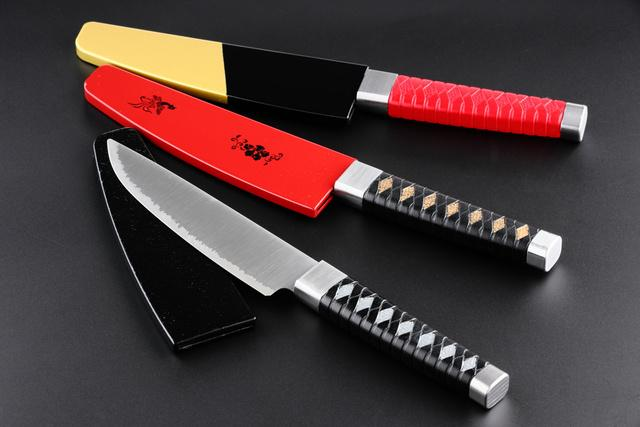The Art of Japanese Knives: Understanding the Cultural Heritage Behind Your Kitchen Tools
- Posted on

The story of Japanese knife-making spans over 1,000 years, intertwining with the nation's samurai heritage, Buddhist philosophy, and deep respect for craftsmanship. This cultural foundation created not just superior cutting tools, but instruments that reflect Japanese values of precision, respect, patience, and the pursuit of perfection through dedicated practice.
Japanese knives represent far more than simple kitchen tools – they embody centuries of cultural tradition, spiritual philosophy, and artistic mastery that transforms the act of cooking into a mindful practice. Understanding the rich cultural heritage behind Japanese cutlery reveals why these blades command such reverence among chefs worldwide and why owning authentic Japanese knives connects you to an ancient tradition of craftsmanship that views knife-making as both art and spiritual discipline.
The story of Japanese knife-making spans over 1,000 years, intertwining with the nation's samurai heritage, Buddhist philosophy, and deep respect for craftsmanship. This cultural foundation created not just superior cutting tools, but instruments that reflect Japanese values of precision, respect, patience, and the pursuit of perfection through dedicated practice.
The Samurai Legacy: From Sword to Kitchen

Japanese knife-making traditions trace their origins directly to the legendary sword-smiths who forged katana for samurai warriors. When the Meiji Restoration of 1868 ended the samurai era, master sword-smiths redirected their centuries-refined skills toward creating kitchen knives, bringing the same meticulous attention to detail, superior metallurgy, and spiritual approach to cutlery production.
The transition from sword to kitchen knife was not merely practical but philosophical. Japanese culture views the kitchen as a sacred space where transformation occurs – raw ingredients become nourishing meals through the cook's skill and intention. The knife, as the primary tool in this transformation, deserves the same respect and craftsmanship traditionally reserved for samurai swords.
This heritage explains why Japanese knives often display the same construction techniques found in historic swords: differential hardening, laminated steel construction, and the pursuit of perfect balance between hardness and flexibility. The spiritual discipline required to master sword-making – patience, precision, and respect for materials – transferred directly to kitchen knife production, creating tools that reflect both functional excellence and artistic beauty.
The famous knife-making regions of Sakai, Seki, and Echizen became centers of cutlery production precisely because they had been historic sword-making locations. Master craftsmen in these areas possessed the generational knowledge and specialized skills necessary to create exceptional blades, maintaining unbroken lineages of technique that continue today.
Philosophical Foundations: The Way of the Knife
Japanese knife culture embraces concepts deeply rooted in Zen Buddhism and traditional Japanese philosophy. The principle of "shokunin" – the craftsman's spirit – emphasizes lifelong dedication to perfecting one's craft through continuous learning and improvement. Master knife-makers embody this philosophy, spending decades refining their skills and seeking ever-greater perfection in their work.
The relationship between chef and knife in Japanese culture reflects the concept of "wa" – harmony between tool and user. A properly made Japanese knife should feel like an extension of the chef's hand, responding intuitively to intention and movement. This harmony develops through time and practice, creating an intimate bond between cook and tool that enhances both technique and mindfulness in the kitchen.
Respect for ingredients forms another cornerstone of Japanese culinary philosophy. Japanese knives are designed to preserve ingredient integrity through clean, precise cuts that minimize cellular damage and maintain natural flavors and textures. This approach reflects the broader Japanese principle of honoring the natural essence of ingredients rather than masking or overwhelming their inherent qualities.
The meditation-like process of proper knife maintenance also reflects Japanese spiritual practices. Sharpening, cleaning, and caring for Japanese knives becomes a mindful ritual that connects the user to the tool's history and purpose. This ceremonial aspect transforms routine maintenance into meaningful practice, deepening appreciation for both the knife and the cooking process.
Regional Traditions and Distinctive Styles

Japan's diverse knife-making regions each developed distinctive styles and specializations that reflect local culture, available materials, and culinary traditions. Understanding these regional differences provides insight into how geography and culture shaped Japanese knife development over centuries.
Sakai, near Osaka, became renowned for single-bevel knives used in traditional Japanese cuisine. The city's location as a major trading port provided access to high-quality steel materials, while its proximity to Kyoto's imperial court created demand for precision knives capable of the exacting standards required for kaiseki cuisine. Sakai craftsmen developed techniques for creating asymmetrically ground blades that offer unparalleled precision for sushi and sashimi preparation.
Seki, in Gifu Prefecture, earned fame for producing both samurai swords and later kitchen knives. The region's abundant water sources and iron ore deposits created ideal conditions for blade-making, while the concentration of skilled craftsmen fostered continuous innovation and technique refinement. Seki knives typically feature excellent balance and durability, reflecting the region's emphasis on practical performance.
Echizen, in Fukui Prefecture, developed its own distinct forging traditions, often incorporating unique steel compositions and heat treatment methods. The region's craftsmen became known for creating knives with exceptional edge retention and distinctive aesthetic qualities that reflect local artistic sensibilities.
Each region's knives bear subtle hallmarks that reflect their cultural heritage – from blade profiles that suit local cutting techniques to handle styles that reflect regional aesthetic preferences. These regional variations demonstrate how Japanese knife-making traditions adapted to local needs while maintaining core principles of quality and craftsmanship.
Traditional Construction Methods and Spiritual Significance
Japanese knife construction involves numerous traditional techniques that carry deep cultural meaning beyond their practical benefits. The process of creating a Japanese knife is viewed as a spiritual journey that requires patience, respect, and mindful attention to every detail.
Tamahagane steel production, while rarely used for modern kitchen knives, represents the pinnacle of traditional Japanese metallurgy. This ancient process involves smelting iron ore and charcoal in clay furnaces called tatara, creating steel through a multi-day process that requires constant attention and spiritual focus. While modern steel alloys have largely replaced tamahagane for practical reasons, the reverence for this traditional process continues to influence contemporary knife-making approaches.
The forge-welding techniques used to create laminated blade construction reflect Japanese principles of harmony and balance. By combining different steel types – hard cutting cores with softer, more flexible exteriors – craftsmen create blades that embody the Japanese concept of finding strength through balanced opposing forces. This construction method requires precise temperature control and timing that can only be mastered through years of dedicated practice.
Heat treatment processes in Japanese knife-making involve carefully controlled cycles of heating and cooling that develop specific grain structures within the steel. Master craftsmen read subtle color changes in heated steel to determine precise timing, relying on intuition developed through decades of experience. This intimate understanding of materials reflects the Japanese appreciation for subtle nuances and the pursuit of perfection through dedicated observation.
The hand-finishing processes that create the final blade geometry and surface finish are performed with tools and techniques passed down through generations. Each step requires careful attention and respect for the blade's intended purpose, transforming raw forged steel into a refined cutting instrument worthy of its cultural heritage.
Modern Applications of Ancient Wisdom
Contemporary Japanese knife-makers continue honoring traditional methods while adapting to modern materials and techniques. This evolution demonstrates how cultural heritage can remain relevant and valuable in changing times, providing timeless principles that enhance modern practice.
Modern stainless steel alloys like VG-10 and SG2 incorporate traditional Japanese forging wisdom with contemporary metallurgy, creating knives that offer superior performance while maintaining the aesthetic and cultural values of their ancestors. These materials allow knife-makers to achieve the performance characteristics valued in traditional Japanese knives while providing the corrosion resistance demanded by modern kitchens.
The integration of traditional aesthetics with contemporary functionality appears in modern Japanese knife design, where classical blade profiles and handle styles accommodate modern ergonomic requirements and food safety standards. This synthesis demonstrates how cultural heritage can enhance rather than limit innovation.
Professional chefs worldwide increasingly appreciate not just the performance advantages of Japanese knives, but the mindful approach to cooking that these tools encourage. Western vs. Japanese Knives: Key Differences and Why Chefs Often Prefer the Japanese Style explores how the cultural philosophy behind Japanese knife design creates practical advantages that extend beyond simple cutting performance.
Preserving Cultural Heritage Through Proper Care
Understanding the cultural significance of Japanese knives naturally leads to appreciation for traditional maintenance methods that honor both the tool and its heritage. Proper care becomes not just practical necessity but cultural practice that connects modern users to centuries of knife-making tradition.
The ritual aspects of Japanese knife maintenance reflect broader cultural values of respect, patience, and mindful attention to detail. Caring for Your Japanese Cutlery: Traditional Maintenance Techniques for Modern Kitchens provides comprehensive guidance on maintaining these cultural treasures using methods developed over centuries of dedicated practice.
Traditional maintenance techniques involve more than preserving cutting performance – they represent ongoing dialogue between user and tool that deepens understanding and appreciation. The meditative aspects of proper knife care create opportunities for reflection and connection with the cultural heritage these tools represent.
Connecting to Tradition in Modern Kitchens
Owning authentic Japanese cutlery provides direct connection to this rich cultural heritage, transforming everyday cooking into practice that honors centuries of craftsmanship and philosophical development. Each time you use a traditional Japanese knife, you participate in cultural traditions that value precision, respect, and mindful engagement with the cooking process.
The cultural heritage behind Japanese knives offers modern cooks more than superior cutting tools – it provides framework for approaching cooking with greater mindfulness, respect, and appreciation for the ingredients and processes involved in creating nourishing meals. This perspective transforms routine meal preparation into meaningful practice that enriches both cooking results and personal satisfaction.
Conclusion
Japanese knives embody cultural heritage that extends far beyond their practical function, representing centuries of spiritual practice, artistic development, and philosophical refinement. Understanding this heritage enhances appreciation for these remarkable tools while providing insight into cultural values that created some of the world's finest cutlery.
The art of Japanese knives demonstrates how cultural tradition can enhance modern practice, providing timeless principles that improve both technique and mindfulness in contemporary kitchens. By honoring this heritage through proper use and care, modern cooks participate in living tradition that connects past wisdom with present practice, creating meaningful relationships with both tools and cooking process that enrich the entire culinary experience.

